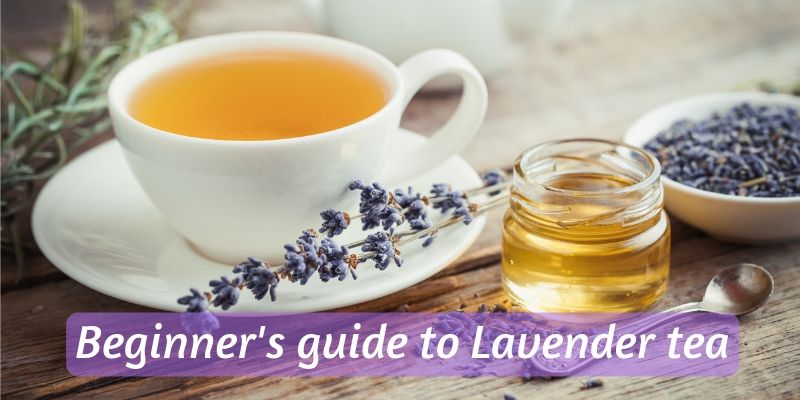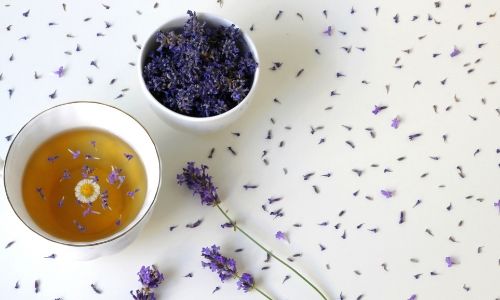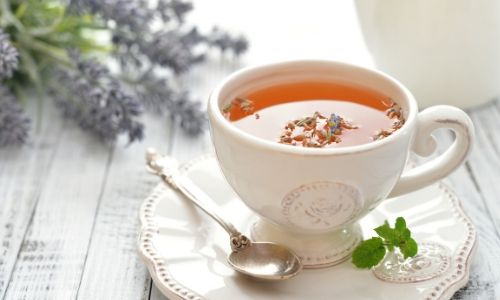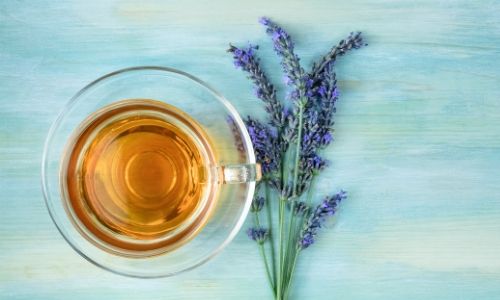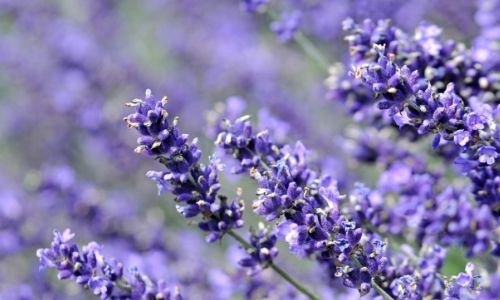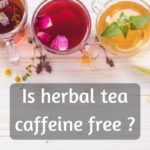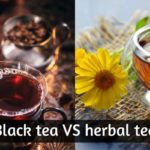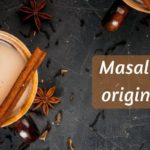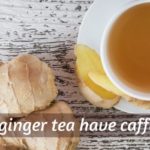Lavender tea is one of those herbal brews that sound fancy, but you're not quite sure what they're all about. It sounds elegant, yes, but what is lavender tea, really ?
And what is lavender tea good for, anyway ?
Well, this is what I'm going to help you with, since this guide is going to be all about lavender tea, and how it can help you improve your sleep, reduce anxiety, and where this tea comes from in the first place. So let's get to it.
Table of Contents
What is lavender tea ?
Lavender tea is the herbal brew resulted from steeping dried lavender flowers in hot water for several minutes (about 5). It's a very common and well known herbal tea, and lavender essential oil is heavily used in aromatherapy and cosmetics.
While lavender tea is common, it's less known that green or black tea, at least in the U.S.A. But you'll see this tea very often in bedtime tea recipes, or teas meant to calm nerves, aid with relaxation or simply reduce anxiety.
If you've never had lavender tea before then you're going to find this guide very helpful, as it contains everything a beginner needs to know about lavender, and lavender tea.
Where does lavender grow ?
Lavender is native to Europe, however it's now being grown nearly everywhere around the world. A certain part of France (Provence) is very famous for successfully growing large fields of lavender, as well as other aromatic herbs.
Lavender grown in Provence fetches a higher price on the market, partly due to its higher quality, and partly due to the hype around it.
This is all because Provence actually has the. best. weather. for growing large fields of lavender, so it will of course fetch a higher price.
Otherwise you can find wild lavender, though it might be less impressive than the one cultivated for its scent in dedicated fields.
What kind of lavender is used for tea ?
There's about 39 different types of lavender across the entire planet, some more precious than others. Most of the time they're used as ornamental flowers, but some of them are actually edible, and are also used in coking.
Lavandula augustiflora is the one commonly used for tea and cooking, and is otherwise known as English lavender, or simply lavender.
That is not to say that other lavender types are unsuited for culinary use, but they might offer a different flavor.
Only use dried lavender flowers to make tea
When making a cup of lavender tea, you will need the dried flowers of the lavender plant. The leaves cannot be used, since they provide no flavor.
If you were to use raw, fresh flowers you'd have a herbal note that's not going to sit well with many people. You're essentially scalding the fresh flowers in hot water, so it won't come out well.
For this reason dried flowers are preferred, and also offer the best cup of tea possible. You're going to find that you won't need very much to make a cup of lavender tea, since this drink has a very strong scent and flavor.
How to make lavender tea
Alright, now let's get to actually brewing some lavender tea. You're going to find this process pretty easy, since this is a herbal tea. This means it won't go bitter if you steep it too long, like green tea or black tea.
It also means you won't have any trouble making it at home, since timing and serving sizes aren't as strict as true teas.
You can easily brew this tea in the comfort of your own home.
What you'll need for a cup (8 oz/233 ml) of lavender tea:
- 9 oz/266 ml hot water, 90 C/194 F
- a heaping teaspoon of dried lavender buds
- cup or mug to hold the drink
- some sort of filter or strainer to separate the flowers from the tea
You're going to need more than 8 oz/233 ml of water for the tea because a part of it will be absorbed by the flowers. This is why I recommend you add another ounce/33 ml, to compensate.
Now, when heating your water make sure you're not using the microwave. This is because heating water in a pot or kettle on the stove is going to evenly chance the temperature of the water, without making any hot or cold pockets as a microwave might.
And also the best way to actually brew tea, at least when brewing a single serving, is to steep the tea in the actual mug you're going to drink from.
This is why I think this Sweese tea mug is a pretty cool idea. It's a porcelain mug, and it comes with a stainless steel filter that gets inserted in the mug, and a porcelain lid to keep your drink hot. Or, you can use it as a coaster or trivet to hold the filter once you're done brewing.
It's a large tea mug, and it can hold up to 15 oz of liquid, which means you're probably going to have to use almost two teaspoons of lavender flowers for this mug.
You can find the listing on Amazon here, and read the reviews as well.
Once you're figured out what you want to drink your tea from, proceed with heating the water. Once it's got the right temperature (90 C or 194 F) you can add the lavender flowers to it, or the other way around, depending on what method you're using.
You're going to need to steep the flowers for about 5 minutes. You can steep them longer if you like, and this will result in a stronger tea though it can very quickly become overpowering.
Once you're steeped the flowers, you're going to remove them from the tea - either by removing the filter, or straining the liquid into a cup, whichever way you like.
You should be left with a very, very fragrant cup of tea, and it's not going to look purple, unfortunately. It's actually going to be a sort of light amber.
The best way to try this lavender tea is, of course, to actually make your own. Lavender is very often found in bedtime teas, but this doesn't mean you can't brew your own lavender tea at home just for the hell of it. And the smell.
This is why I'd recommend this 4 oz/113 gr pack of dried organic lavender flowers from Feel Good Organics.
They've got a nice, resealable bag and the whole serving can last you about 60 cups of tea, possibly more, depending on how much you're using for one cup.
The lavender used in this pack comes from the fields of Southern France, and are organic (certified USFDA).
If you'd like a larger size, they also come in 16 oz/453 grams packs as well.
You can find the listing on Amazon here, and read the reviews as well.
What does lavender tea taste like ?
Your lavender tea will taste like, you guessed it, lavender. I mean really, it will taste pretty much the same as it smells, this is not one of those teas that smell great and taste different (like ginger for example).
Another comparison I can make is jasmine tea. Lavender is a very fragrant flower, with a sort of deep, musky smell, without being too spicy. It's almost suffocating in some cases.
Very much like jasmine, and if you've ever had jasmine green tea you know just a few flowers are enough to really drive that flavor home.
Lavender tea will taste very flowery, as one might expect from a flower-based tea. Like rose tea, it's going to be very fragrant and maybe remind you of honey a little bit.
Consider this. Lavender is a very sweet and strong smelling flower to begin with. As this sort of scent becomes ridiculously powerful in warm settings, like in the summer heat or in your cup of hot tea.
So be careful when brewing this tea because you can very easily make it too strong.
How much lavender should you put in tea ?
It kind of depends on what you're used to, and what you're trying to achieve. If you like your lavender tea a little strong, and actually do enjoy lavender then a heaping teaspoon is going to be just fine for you, for an 8 oz/233 ml of brewed tea.
If you'd like your lavender tea a little weaker, like more of a nice fragrance and sort of hint of lavender, then probably go for half a teaspoon.
And if you're meaning to brew another tea with lavender - such as chamomile or valerian - then you're going to have to use just half a teaspoon, since you need to let the other tea shine as well.
One of the best combinations I've noticed is vanilla, lemon and lavender, at least in terms of essential oils and relaxation. I've never gotten my hands on actual vanilla pods to brew some tea, but when I do I'm going to let you know.
Lavender tea latte
I wanted to address this a bit. What's all the hype about lavender tea latte ? Well, this is one of the things that's actually got my attention, and sounds and tastes amazing.
Normally when you brew lavender tea you get a cup of lavender tea that's going to take up all the room in your cup and there is no way you can make a latte with it.
But. If you were to make a lavender 'espresso', except with a longer brewing process, you could easily pull off a lavender tea latte.
All you have to do is brew your heaping teaspoon of dried lavender flowers in 1.3 oz/40 ml of hot water, for about 10 minutes. We need the strongest lavender tea we can get.
Once it's steeped, strain the flowers and add in about 4 oz/118 ml steamed milk, complete with microfoam and frothed milk. A guide on how to steam milk at home is here.
This should result in a large-ish drink, since the frothed milk takes up quite a bit of space.
Some people like to add in a bit of food coloring, to turn the drink a very light purple. Others like to make the lavender flavor even more pronounced and add a drop of lavender essential oil as well.
I think you should try it in its basic version first, and then see if you need to add anything else.
Lavender tea benefits and side effects
Making your own lavender tea at home is very rewarding, but being aware of its health benefits and possible side effects is something we all have to work on.
Lavender is a very popular herb, and it can be found in several drinks and foods, sometimes even just as garnish.
But this herb's got a whole slew of health benefits, seeing at it's been used by the Romans over 2000 years ago. So at least some of its medicinal properties were known back then, and in recent times we've only delved deeper into the topic.
Lavender tea helps you fall asleep
This is probably one of the most well known effects of lavender, and it carries over to its tea very well.
There's something about the fragrance of lavender that just lets the brain relax and release its 'feel good' signals. This, coupled with drinking a warm liquid before bed, combined and creates a very powerful and soothing drink.
Lavender has been used by those with sleep troubles for centuries, and it's proven useful time and time again. It's one of the key ingredients in bedtime teas, along with valerian tea, and chamomile tea.
What you can do to help you sleep better, aside from just drinking lavender tea, is to place a drop of lavender essential oil on a cotton bud and place it near your bed. Do not put it on your bed or too close to your head, since that scent is very, very strong.
Another option is to use lavender flower sachets, which will have a more subdued smell and can actually be placed among your pillows.
Lavender tea for anxiety
The same way lavender helps with sleep, it will also help with anxiety and relieving stress. The very scent of lavender will help in this respect, and drinking the tea will also provide a calming experience.
Most of the studies done on lavender show that you need to take lavender-based products (like tea, dried powdered flowers, essential oils, and so on) for at least 2 weeks to see any significant results in treating anxiety.
As with anything herbal, treatment produces results only in the long run since it works in small doses, so if you're planning on taking lavender in one way or another to help reduce anxiety or manage stress then you will need to consider a treatment spanning several weeks.
It's best to also consult your doctor before beginning any such treatment.
Lavender can be good for inflammations
It seems that lavender is good at reducing swelling and inflammations, if applied regularly, several times a day for several days.
For example in the case of canker sores applying lavender essential oil 3 times a day directly tot eh sore helps reduce pain and the amount of time the sore needs to go away.
As a result of this mechanism lavender can help with reducing muscle pains, including menstrual pains. They will not go away completely, but they can become more manageable, including PMS symptoms such as back pain or stomach aches.
Lavender tea and pregnancy
Lavender seems to be on the list of teas that are unsafe for pregnant women, or nursing women and infants for that matter.
This is because it needs more studies into how it can affect the development of the unborn child, though some results suggest a possible hormone imbalance leading to male babies developing breasts.
However that particular hormonal imbalance can be the result of several other factors, so again more research is needed.
Lavender used in very small amounts or as seasoning is safe for pregnant women, for example lavender flavored desserts of a salad with a couple of lavender flowers ground and added as seasoning.
But products made entirely out of lavender or mostly out of lavender should not be directly ingested by pregnant women - like pure lavender tea, or lavender essential oil.
Does lavender tea have caffeine ?
Lavender tea has no caffeine at all. Lavender (the herb) has no caffeine, and neither does its infusion.
If you do find a 'contains caffeine' label on your lavender tea pack, it's because it's been added. Some teas are intentionally caffeinated, and others are blended with green or black tea, which contain their own caffeine.
In fact you'll find that lavender is a key ingredient in many bedtime teas, or teas meant to help reduce stress and anxiety. Having any caffeine in these teas would be ineffective.
Lavender tea side effects
One of the side effects lavender ma be linked to is breast development in little boys. This effect is apparently temporary, and is reversed once the lavender treatment is interrupted. Not all little boys have this reaction, but some might.
Another side effects of lavender is its very strong smell. If you're very sensitive to smell (some people can't stand perfume or strong scents) and find you get a headache or dizzy whenever you smell lavender, stop using it.
Other side effects of lavender may be constipation, headache, and severe change in appetite. This is due to consuming excessive amounts of lavender, but it might also happen to people who are very sensitive to lavender (allergic) and only take a small amount.
On the whole though, lavender is judged to be likely safe for most people, and most probably won't send you to the hospital.
Conclusion
Lavender tea is one of those drinks many people will enjoy, but might need a break from every now and then, as this can be a strong tasting tea.
Lavender by itself is a very beautiful flower, and its calming effects might just be what you were looking for after a long, hard day, or during a stressful period.
If you want to know more about coffee or tea, feel free to check the related articles below. Who knows what else you might find ?

